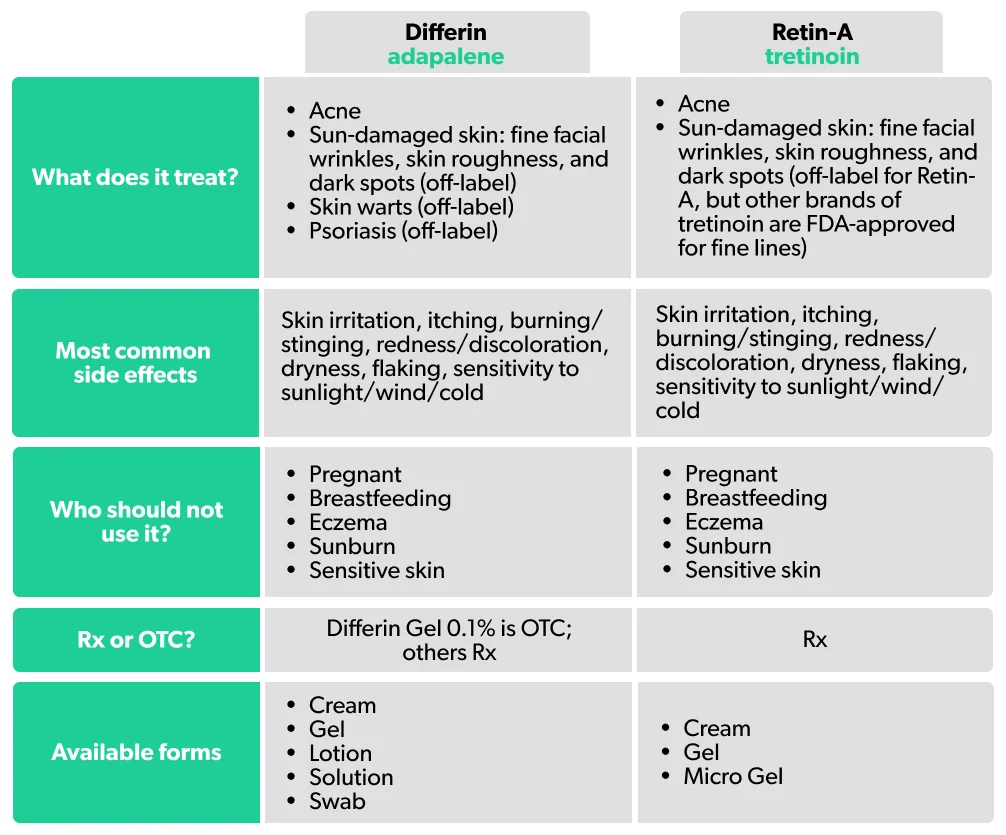Here's what we'll cover
Here's what we'll cover
Aging is a natural process, but some of us would like to slow down its effects on our skin. If you’re looking to fight wrinkles, you may be considering a retinoid, such as adapalene (brand name Differin) or tretinoin (brand name Retin-A). They’re both topical medications, which means you apply them directly to your skin. But what’s the difference between these medications? Keep reading to find out.
What are adapalene and tretinoin?
Adapalene and tretinoin belong to a drug class called retinoids, a group of compounds derived from vitamin A. The retinoid drug class includes oral medications (taken by mouth) and topical medications (applied to the skin). All oral retinoids require a prescription from a healthcare provider or dermatologist. Topical retinoids are available by prescription and over the counter (Yoham, 2021).
Retinols are a type of retinoids but are less potent. Adapalene and tretinoin are considered topical retinoids, not retinols.
Tretinoin Important Safety Information: Read more about serious warnings and safety info.
What is adapalene (Differin)?
Adapalene (brand name Differin) is a newer-generation topical retinoid medication. It is typically applied once daily. Differin gel comes in two strengths: 0.1%, which is over-the-counter (OTC), and 0.3%, which is prescription-only (Rx). Differin lotion, cream, solution, and swab are Rx-only (Tolaymat, 2022; DailyMed-a, 2021; DailyMed, 2020).
Adapalene is also an ingredient in some combination acne medications, such as Rx Epiduo (adapalene and benzoyl peroxide).
What is tretinoin (Retin-A)?
Retin-A is a brand-name prescription drug that contains the active ingredient tretinoin. The FDA first approved tretinoin in the 1970s as a treatment for acne. It is usually applied once a day, in the evening. Tretinoin is not available OTC (FDA, n.d.).
Retin-A comes in a cream (0.1%, 0.05%, or 0.025%) and a gel (0.01%, 0.025%). Retin-A Micro, a microsphere gel formulation, is also available by Rx in several strengths (DailyMed, 2019; DailyMed, 2017).
Conditions treated with adapalene and tretinoin
The most common uses for adapalene and tretinoin are (Tolaymat, 2022; Yoham, 2021):
Acne—Also known as acne vulgaris, this skin condition occurs when your pores become clogged, leading to pimples.
Sun-damaged skin—Photoaging is the medical term for skin changes that occur over time due to sunlight exposure. These signs of aging include wrinkles, fine lines, texture changes, and hyperpigmentation (dark spots or “sun spots”). Tanning and sunbathing can accelerate these changes.
Adapalene uses
The Food and Drug Administration (FDA) approves adapalene to treat acne (DailyMed-b, 2021).
Providers may also prescribe adapalene off-label (meaning it’s not FDA-approved for these purposes, but the provider deems it an appropriate treatment for their patient) to fight the signs of sun damage, such as fine lines, skin roughness, and dark spots. Other off-label uses for adapalene include psoriasis, rosacea, warts, pigmentation disorders, alopecia areata, and other inflammatory skin conditions (Rusu, 2020).
Tretinoin uses
The FDA approves Retin-A (tretinoin) to treat acne.
Several other brand-name Rx drugs also contain tretinoin. One example is Renova, a cream FDA-approved to manage fine facial wrinkles as part of a comprehensive skincare routine that includes avoiding sunlight exposure (FDA, 2014).
Tretinoin is also an ingredient in Tri-Luma, an Rx cream. The FDA approves it to treat melasma of the face, a skin condition that causes patches or spots that are darker than your natural skin tone (FDA, 2002).
Is adapalene or tretinoin better for wrinkles?
Adapalene and tretinoin seem to be similar in how well they work for wrinkles.
In a clinical trial, adapalene 0.3% gel was just as effective as tretinoin cream for treating sun-damaged skin. Participants were randomly assigned to use either adapalene or tretinoin for 24 weeks. The two treatments had similar results in improving the appearance of forehead wrinkles, eye-area wrinkles (“crow’s feet”), dark spots, and rough patches (Bagatin, 2018).
Along with daily sunscreen and a healthy lifestyle, using a topical retinoid may help some people achieve clear, damage-free skin.
Side effects of adapalene and tretinoin
Adapalene and tretinoin commonly cause similar side effects, such as (Tolaymat, 2022; Yoham, 2021):
Skin irritation
Itching
Burning or stinging
Redness or discoloration, depending on your natural skin tone
Dryness
Flaking
Sensitivity to sunlight and windy or cold weather
New or worsened acne lesions (in early weeks of treatment)
Adapalene and tretinoin commonly cause skin irritation, especially in the first one to two weeks. Your healthcare provider will likely offer tips to minimize these side effects, like the following:
Start with every-other-day use for the first few weeks.
Less is more—a pea-sized amount of the product is all you will need to apply a thin layer to your face.
After washing your face, be sure to allow your skin to dry completely before applying the medication.
Be sure to use a gentle moisturizer to combat dryness and a daily sunscreen to protect against sunburn.
While individual results may vary, adapalene typically causes less severe side effects than tretinoin. Retin-A Micro gel tends to have better tolerability than tretinoin cream (Kolli, 2019; DailyMed, 2017).
Potential drug interactions of adapalene and tretinoin
Adapalene and tretinoin are not meant to be used together. You should also consult a healthcare professional before using a retinoid if you use topical medications to treat other skin conditions, such as eczema.
It is also important to note that certain ingredients in skin care products can make your skin dry and more vulnerable to irritation from retinoids. While using adapalene or tretinoin, avoid using cosmetics or other skin care products that contain (FDA, 2018; DailyMed, 2021):
Alcohol
Astringent
Lime
Resorcinol
Sulfur
Additionally, waxing is not recommended with retinoids. Using this hair removal method may cause painful skin peeling and damage.
Differences and similarities between adapalene vs. tretinoin
Here’s a summary of how these drugs compare:

DISCLAIMER
If you have any medical questions or concerns, please talk to your healthcare provider. The articles on Health Guide are underpinned by peer-reviewed research and information drawn from medical societies and governmental agencies. However, they are not a substitute for professional medical advice, diagnosis, or treatment.
American Academy of Dermatology (AAD). (2021). Retinoid or retinol? Retrieved on May 4, 2022 from https://www.aad.org/public/everyday-care/skin-care-secrets/anti-aging/retinoid-retinol
Bagatin, E., Gonçalves, H. S., Sato, M., et al. (2018). Comparable efficacy of adapalene 0.3% gel and tretinoin 0.05% cream as treatment for cutaneous photoaging. European Journal of Dermatology, 28 (3), 343–350. doi:10.1684/ejd.2018.3320. Retrieved from https://pubmed.ncbi.nlm.nih.gov/30105991/
Kolli, S. S., Pecone, D., Pona, A., et al (2019). Topical retinoids in acne vulgaris: a systematic review. American Journal of Clinical Dermatology , 20(3), 345–365. doi:10.1007/s40257-019-00423-z. Retrieved from https://pubmed.ncbi.nlm.nih.gov/30674002/
Rusu, A., Tanase, C., Pascu, G. A., & Todoran, N. (2020). Recent advances regarding the therapeutic potential of adapalene. Pharmaceuticals, 13 (9), 217. doi:10.3390/ph13090217. Retrieved from https://www.ncbi.nlm.nih.gov/pmc/articles/PMC7558148/
Tolaymat, L., Dearborn, H., & Zito, P.M. (2022). Adapalene. StatPearls . Retrieved on May 4, 2022 from https://www.ncbi.nlm.nih.gov/books/NBK482509/
U.S. Food and Drug Administration (FDA). (n.d.) FDA-approved drugs. Retrieved on May 4, 2022 from https://www.accessdata.fda.gov/scripts/cder/daf/
U.S. Food and Drug Administration (FDA). (2012). Differin (adapalene) gel, 0.3%. Retrieved on May 4, 2022 from https://www.accessdata.fda.gov/drugsatfda_docs/label/2012/021753s004lbl.pdf
U.S. Food and Drug Administration (FDA). (2013). Differin (adapalene) lotion, 0.1%. Retrieved on May 4, 2022 from https://www.accessdata.fda.gov/drugsatfda_docs/label/2013/022502s003lbl.pdf
U.S. Food and Drug Administration (FDA). (2014). Renova (tretinoin cream) 0.02%. Retrieved on May 4, 2022 from https://www.accessdata.fda.gov/drugsatfda_docs/label/2014/021108s015lbl.pdf
U.S. Food and Drug Administration (FDA). (2018). Differin (adapalene) gel 0.1% carton label . Retrieved on May 4, 2022 from https://www.accessdata.fda.gov/drugsatfda_docs/label/2018/020380Orig1s013lbl.pdf
U.S. Food and Drug Administration (FDA). (2002). Tri-Luma (Fluocinolone Acetonide/Hydroquinone/Tretinoin) Cream. Retrieved on May 4, 2022 from https://www.accessdata.fda.gov/drugsatfda_docs/nda/2002/21-112_Tri-Luma.cfm
U.S. National Library of Medicine: DailyMed. (2020). Adapalene swab. Retrieved on May 4, 2022 from https://dailymed.nlm.nih.gov/dailymed/drugInfo.cfm?setid=5ce78048-0e5c-45b5-82bf-9f61307611cd
U.S. National Library of Medicine: DailyMed-a. (2021). Adapalene topical solution. Retrieved on May 4, 2022 from https://dailymed.nlm.nih.gov/dailymed/drugInfo.cfm?setid=d30d225c-65cc-7769-e053-2995a90a98d6
U.S. National Library of Medicine: DailyMed-b. (2021). Differin (adapalene) cream, 0.1%. Retrieved on May 4, 2022 from https://dailymed.nlm.nih.gov/dailymed/fda/fdaDrugXsl.cfm?setid=ab4b2120-57fc-6c61-b239-37c21789c065&type=display
U.S. National Library of Medicine: DailyMed. (2017). Retin-A Micro tretinoin gel. Retrieved on May 4, 2022 from https://dailymed.nlm.nih.gov/dailymed/fda/fdaDrugXsl.cfm?setid=08ab7e0c-1437-455f-815c-98904d96a289&type=display
U.S. National Library of Medicine: DailyMed. (2019). Retin-A tretinoin cream; Retin-A tretinoin gel. Retrieved on May 4, 2022 from https://dailymed.nlm.nih.gov/dailymed/drugInfo.cfm?setid=9556d73d-c573-4e0a-9feb-764ce2d1107b
Yoham, A. & Casadesus, D. (2021). Tretinoin. StatPearls . Retrieved on May 4, 2022 from https://www.ncbi.nlm.nih.gov/books/NBK557478/










